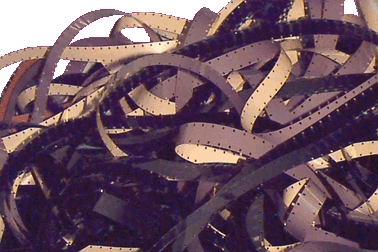
So, without all that strict hydrogen bonding, the cellulose nitrate and the cellulose acetate can be dissolved in a solvent and cast into films. See a comparison of their structures here.
| It turns out that films made from cellulose nitrate are pretty darn tough and durable, and were used in early movie films. Picture this, though -- a hot light bulb shining bright and close to that flammable cellulose nitrate film -- poof! Fire! And, the long-term chemical stability is not good. That's why film preservation organizations are working so hard to keep from losing those precious early movies filmed on cellulose nitrate. For more about the history of polymers in movie films, visit the Macroplex in the Macrogalleria. |
 |
According to ICI Nobel Enterprises, a major manufacturer of cellulose nitrate, current uses include: printing inks, wood lacquers, foil and film lacquers, auto refinish paints, nail lacquers, and leather finishes, with miscellaneous applications in adhesives, foil coatings, artificial jewelery, and others! (Surprising, huh?!) Their advertising emphasizes the clarity, toughness, and durability of films that contain cellulose nitrate.
Cellulose acetate is also spun into fibers and woven to make fabrics. Ever see "acetate" written on a clothes label? That's cellulose acetate, spun into fibers instead of being cast into a film!

|
One of the uses of cellulose acetate is clothing fibers and fabric - otherwise known as "tuxedo taffeta"! Another use is in some candy wrappers. |

|
Now, you know that cellulose nitrate is dramatically flammable, but what about cellulose acetate -- how does it burn? How do both of them compare with cellulose? Continue on to find out.

|

|

|